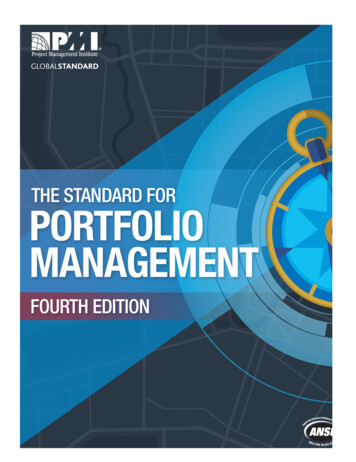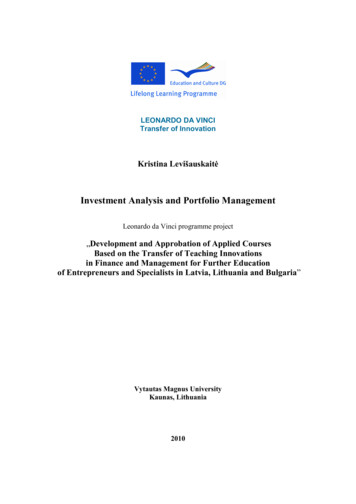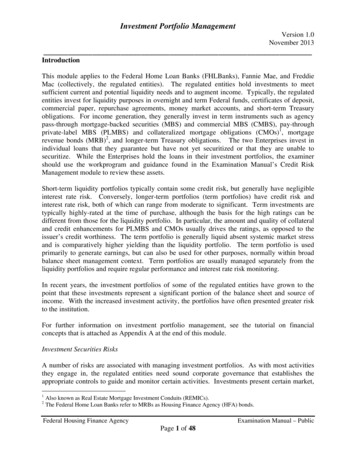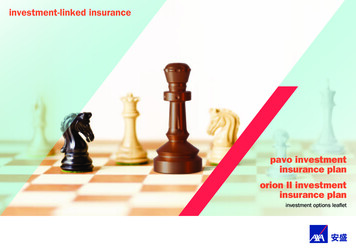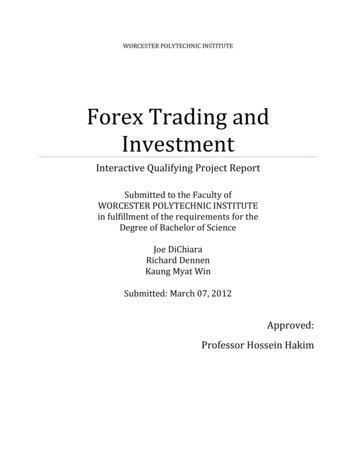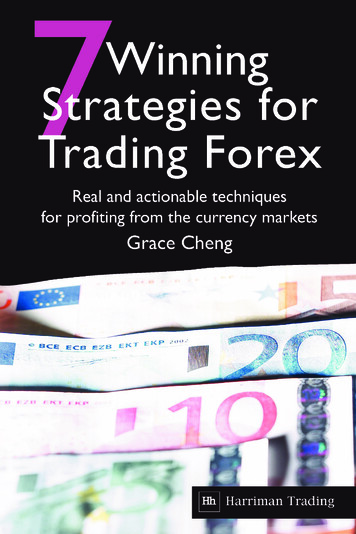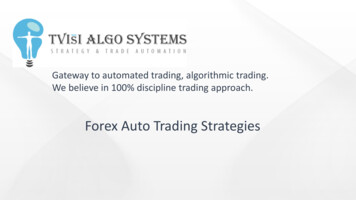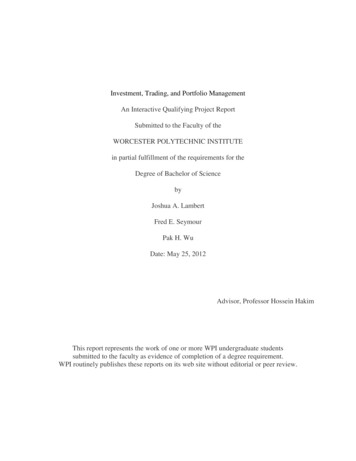
Transcription
Investment, Trading, and Portfolio ManagementAn Interactive Qualifying Project ReportSubmitted to the Faculty of theWORCESTER POLYTECHNIC INSTITUTEin partial fulfillment of the requirements for theDegree of Bachelor of SciencebyJoshua A. LambertFred E. SeymourPak H. WuDate: May 25, 2012Advisor, Professor Hossein HakimThis report represents the work of one or more WPI undergraduate studentssubmitted to the faculty as evidence of completion of a degree requirement.WPI routinely publishes these reports on its web site without editorial or peer review.
AbstractThe goal of this project was to get a solid understanding of the forex market in order tolaunch a money management company. In order to be successful in terms of trading, manymethods regarding forex trading were considered and were systematically tested to determine thebest strategies. This included using different fundamental and technical indicators, andprogramming. To launch a money management company, the legal structure, location, moneymanagement, risk management, government regulation, licensing, and marketing strategies wereexamined.ii
Table of ContentsAbstract . iiList of Figures . vii1.0 – Introduction . 11.1 – History of Finance/Markets . 11.2 – Project Overview . 22.0 – Background . 42.1 – Overview of the Stock Market and Basic Terms . 42.2 – The Forex Market . 53.0 – Methodology - Trading in the Forex Market . 83.1 – Trading Platforms . 83.1.1 – MetaTrader4 . 83.1.2 – TradeStation 9.0 . 123.2 – Example Trading Plan/Strategy . 163.3 – Money Management . 193.3.1 – Loss Management . 193.4 – Fundamental Indicators . 193.4.1 – GDP. 203.4.2 – Nonfarm Payroll. 203.4.3 – Interest Rate . 213.5 – Technical Indicators . 213.5.1 – Support/Resistance . 223.5.2 – Fibonacci Indicator . 233.5.3 – Elliott Wave Theory. 243.5.4 – FOREX Pivot Point. 273.5.5 – Bollinger Bands . 283.5.6 – Moving Averages . 303.5.7 – Simple Moving Averages . 313.5.8 – Exponential Moving Averages . 323.5.9 – FOREX Stochastic Indicator. 343.5.10 – MACD Indicator . 35iii
3.5.11 – CCI Indicator . 363.5.12 – Average True Range Indicator . 383.5.13 – ADX Indicator . 393.5.14 – Parabolic SAR . 413.5.15 – Relative Strength Index. 423.5.16 – Ichimoku Kinko Hyo . 433.5.17 – Swing Trading . 453.5.18 – Spinning Top and Railway Track . 464.0 – Launching a Forex Money Management Company. 484.1 – Location Advantage . 484.2 – Legal Structure . 494.2.1 – Sole Proprietorship: . 494.2.2 – General Partnership:. 504.2.3 – Limited Partnership:. 504.2.4 – Limited Liability Partnership: . 514.2.5 – Corporation . 514.2.6 – Limited Liability Company. 524.3 – Money and Risk Management . 524.4 – Government Regulation . 534.5 – Licensing . 554.6 – Marketing Strategy. 55Conclusion . 58Recommendations . 59References . 61Appendix A – Global Development and its Impact on the Forex Market . 76A-1 Election of Mr. Yoshihiko Noda as Japan’s new Prime Minister . 76A-2 The Tying of the Swiss National Bank to the Euro . 77A-3 Operation Twist . 79A-4 Japan’s Situation . 81A-5 The Situation in Europe . 81A-6 Euro Zone . 84iv
A-7 Development Late October to Early December 2011. 86A-8 Development January to February 2012 . 90Appendix B – Gartman Letter Summary . 92Thursday November 17th . 92Friday November 18th . 92Monday November 21st. 93Tuesday November 22nd . 93Wednesday November 23rd . 93Thursday November 24th . 93Friday November 25th . 94Monday November 28th . 94Tuesday November 29th . 94Wednesday November 30th . 95Thursday December 1st . 95Friday December 2, 2011 . 96Monday December 5, 2011 . 96Tuesday December 6, 2011. 96Wednesday December 7, 2011 . 97Thursday December 8, 2011 . 97Wednesday January 11th . 98Thursday January 12th . 98Friday January 13th. 98Monday January 16th . 98Wednesday, January 18th . 99Thursday, January 19th . 99Friday, January 20th. 99Friday January 27th. 99Monday January 30th . 100Tuesday January 31st . 100Wednesday February 1st . 100Thursday February 2nd . 100v
Appendix C – Our Trades in the Forex Market . 101Pak’s Trades . 101Sample Trades . 106Josh’s Trades . 110Trade 1 . 110Trade 2 . 111Trade 3 . 113Trades 4 & 5. 114Trades 5 & 6. 116Trade 7 . 117Trades 8 & 9. 119Trade 10 . 120Trade 12 . 123Trade 13 . 124Trade 14 . 125Trade 15 . 126Trade 16 . 127Trades 17, 18, & 19. 128Fred’s Trades . 130Appendix D – Programming Projects . 132Group Project . 133Individual Projects . 139Pak’s Programming Project . 139Josh’s Programming Project . 143Fred’s Programming Project . 144Appendix E – Forex Websites . 147vi
List of FiguresFigure 1 - MT4 Chart Properties . 9Figure 2 - MT4 Order Window . 10Figure 3 - MT4 Stop Loss/Take Profit . 11Figure 4 - Indicators In MT4 . 11Figure 5 - TradeStation 9.0 Window . 12Figure 6 - TradeStation 9.0 Chart . 13Figure 7 - TradeStation 9.0 View Window . 13Figure 8 - TradeStation 9.0 . 13Figure 9 - TradeStation 9.0 Order Bar . 14Figure 10 - Fibonacci Indicator. 24Figure 11 - Colored Elliot Wave Theory; 5 wave trend corrected and reversed by 3 wavecountertrend in a bull market. . 25Figure 12 - Elliott Wave Theory in Action . 27Figure 13 – Forex Pivot Point . 28Figure 14 - Bollinger Bands . 30Figure 15 - Bollinger Bands . 30Figure 16 - 10 EMA, 20 EMA . 31Figure 17 - 5 SMA, 30 SMA, 62 SMA . 32Figure 18 - 30 EMA Compared to 30 SMA . 33Figure 19 - Stochastic Indicator . 34Figure 20 - Stochastic Indicator . 35Figure 21 - MACD in Action . 36Figure 22 - CCI Indicator . 37Figure 23 - Average True Range Indicator . 39Figure 24 - ADX Indicator. 40Figure 25 - ADX Indicator. 41Figure 26 - Parabolic SAR . 42Figure 27 - RSI Example . 43Figure 28 - Ichimoku Kinko Hyo. 44Figure 29 - Swing Trading . 46vii
Figure 30 - Spinning Top . 46Figure 31 - Railway Track . 47Figure 32 - Macroeconomic Issues EURUSD 1.4 Mark . 85Figure 33 - B Term Trade Summary. 102Figure 34 - B Term Trade Summary 2. 105Figure 35 - Trade Methodology Example . 106Figure 36 - Trade Methodology Example 2 . 107Figure 37 - Methodology Example 3 . 108Figure 38 - Trade 1 EURUSD 1-min . 110Figure 39 - Trade 2 EURUSD 1-min . 111Figure 40 - Trade 2 Zoom-in . 111Figure 41 - Trade 3 EURUSD . 113Figure 42 - Trades 4&5 EURUSDD 1-min . 114Figure 43 - Trades 5&6 EURUSD - 15 min . 116Figure 44 - Trades 5&6 EURUSD - 5 min . 117Figure 45 - Trade 7 . 118Figure 46 - Trades 8 & 9 EURUSD, AUDUSD - 5 min. 119Figure 47 - Trade 10 . 120Figure 48 - Trade 11 . 121Figure 49 - Trade 12 . 123Figure 50 - 30 Minute Chart Support Level. 124Figure 51 - Trade 14 EURUSD 5-min . 125Figure 52 - Trade 15 . 126Figure 53 - Trade 16 EURUSD 5-min . 127Figure 54 - Trades 17-19. 128Figure 55 - Fred's Trade Summary . 131Figure 56 - Fred's Trade Summary . 132Figure 57 – 15M chart Results . 134Figure 58 – 15M chart Results . 135Figure 59 Pak's Progam's Backtest, 25MA and 50MA . 140Figure 60 Pak's Program's Backtest, 12MA and 24MA . 140viii
Figure 61 Pak's Program's Backtest, 18MA and 36MA . 141Figure 62 Pak's Program's Backtest, 25MA and 50MA with Stochastic . 142ix
1.0 – IntroductionThe first step anyone must take before trying to invest in the forex market is to develop acomplete understanding of the structure of the stock market and forex markets. There are a lot ofimportant concepts and terminology to learn before one can proceed further in their pursuit ofmanaging money within the forex market. This is a breakdown of the basic terms involved ininvestment and trading. It will cover everything from the basics to different types of analysis andtrading techniques.1.1 – History of Finance/MarketsToday the stock market has millions of investors and billions of dollars in circulation, butthis was not always the case. The first evidence of an exchange system dates back over twohundred years ago in Manhattan, where people would trade silver for slips of paper that said theyowned shares of cargo on ships that came into the harbor on a daily basis. Trade flourished withthis new system.Another practice that led to the institution of the stock exchange was the issuance ofbonds, particularly war bonds. This dates back to the American Colonial War, where thegovernment was selling war bonds to raise funds for the war. The bonds would mature in valueover time and could be exchanged for a profit in a certain number of years. The first banks wouldalso sell shares of their company to raise money. This is very similar to how new companies willsell shares of their companies to investors to raise money in today’s market.At the time, Wall Street was the place where most transactions of this nature would takeplace. As a result, in 1792 a group of twenty-four men signed an agreement, known as the“Button Agreement,” that officially started the New York Stock Exchange (NYSE). They set up1
a system where they would trade shares amongst themselves and charge others fees to trade forthem.There were many stocks that were, in one way or another, not good enough to be tradedwithin the NYSE, and were thus traded on the curb outside. This became known as “curbtrading,” and would eventually develop into what is known today as the American StockExchange (AMEX). These have been joined today by NASDAQ and countless otherinternational stock exchanges. Regardless, trading in the stock market was a new way to makeand manage money, and it was the beginning of a new global economy.The Industrial Revolution in the twentieth century brought with it a surge of activity inthe stock market. As more and more money was flowing through Wall Street, more investorsflocked to the stock market to get their piece of the action. This completely changed the dynamicof the American lifestyle and created many successful entrepreneurs virtually overnight.With the huge surge in activity in the stock market and following the stock market crashof 1929, the government realized it needed to take a more active role in regulating exchange toprotect small investors. For this reason, in 1934 Congress passed the Securities and ExchangeAct, which resulted in the Securities and Exchange Commission (SEC). The SEC is responsiblefor overseeing and regulating all trading within the market.1.2 – Project OverviewIn the past seven months, teams of three to five set out to establish the guidelines forlaunching a successful money management company through investment in the forex market.The research and progress through the duration of the project was split into three major steps thatwould build upon one another and lead to a more complete understanding of the material. Thefirst necessary step was to familiarize ourselves with both the stock market and the forex market2
through research. This research would cover a wide range of topics, from a simple review ofbasic terms and concepts to a complex breakdown of different analysis and trading techniques.The next step would be hands on experience in the forex market, through a real-time simulatedaccount. First, there was a focus on trading individually, familiarizing ourselves with differenttrading platforms, and building a rigid trading and money management plan. The focus thenshifted into trading as a group and developing our trading plans further, both individually and asa group. This would transition quite nicely into the third and final step, which would beconducting research in the necessary attributes of a money management company investing inthe forex market.This paper will cover in depth the necessary background information to legally andcomfortably invest both your own and others’ funds in the forex market. It will be organized tomimic the path through which we progressed our own understanding of the material –concentrating on each individual step in order and developing chronologically. The results of ourresearch reflect our own personal interests and may serve as recommendations. There are thevarious choices and pathways one can take in creating a company of this nature and show whatthe ideal steps were. Ultimately it will be up to the reader to decide what suits them best.3
2.0 – Background2.1 – Overview of the Stock Market and Basic
The goal of this project was to get a solid understanding of the forex market in order to launch a money management company. In order to be successful in terms of trading, many methods regarding forex trading
